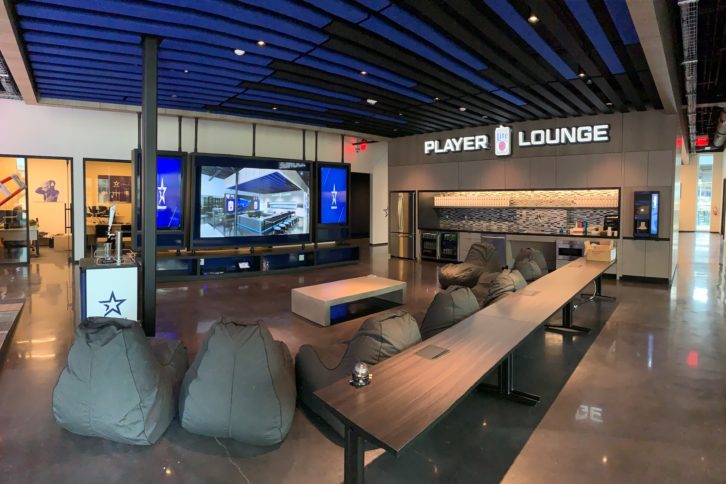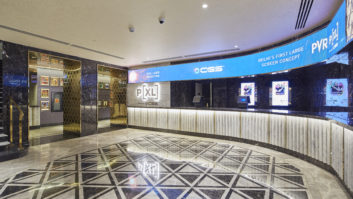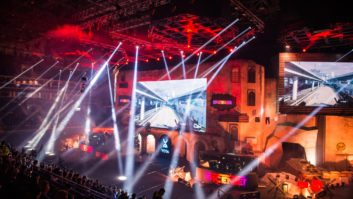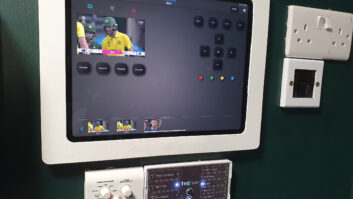
In the first part of this eSports feature we outlined the potential of the market to AV vendors, here David Davies looks at the affect this growth is having on a number of technologies and the priorities of AV integrators.
If we turn our attentions to activities ‘beyond the venue’ then we are increasingly talking about the live-streaming of events to platforms such as YouTube and Twitch. Sometimes the streaming will be masterminded by games companies’ own production operations; sometimes it will involve major production companies with a background in more traditional broadcasting. Broadcast services giant NEP is among the latter, with NEP UK client business manager John Bullen observing that the last few years have seen “eSports become a real focus for growth for us, typically centring upon [events marking] the culmination of online tournaments where there have already been numerous battles involving competing teams.”
As well as being a major growth market, there is also general agreement that eSports is helping to fuel current R&D activities, especially in terms of graphics and data management and interpretation. Sophisticated video production in the venue – which will need to be fully responsive to dramatic occurrences in the gameplay – has to be translated to a streaming experience that captures all of the drama, but without becoming overwhelming. The evolving expectations of game developers – with the method, and extent, to which they require data to be integrated into the visual presentation often varying significantly – mean that broadcast software providers will have to work hard to remain one step ahead.
Jon Finegold, chief marketing officer of file movement software company Signiant, says that “for any company in media technology, the growth of eSports should be considered an exciting opportunity. ESports is driving growth in remote production operations, new graphics and special effects capabilities, and of course more integration with social media.” In terms of Signiant’s area of expertise, “that means more content moving back and forth from the venue to post-production facilities, and edited content then being sent back to the venue and out to social media and other publishers.”
Cloud-based production is set to play a growing role as eSports businesses tackle the question of how to “remain agile and easily plug and play new technologies whether ‘at home’, at the venue or in the cloud,” says Finegold.
Feeding both venue and broadcast feeds with data means that this is currently a major pivot of cloud-related activity. Deployments of Bannister Lake’s Chameleon typically use the company’s own cloud solution to manage and aggregate real-time and static data. But in terms of deciding which data elements reach viewers, an editorial overview remains key; otherwise, says Vern Freedlander, head of strategic partnerships at Bannister Lake, “the amount of data [being conveyed to viewers] could be overwhelming, so there has to be an editorial decision in terms of what fans want, and what will add value to the game and their experience of it. This has to happen [at the start of each project] so the story of the event can be told in a sophisticated way.”
As in all aspects of data management, it’s probable that the use of AI and machine learning in understanding viewer and participant behaviour – and optimising the experience accordingly – will increase markedly as the 2020s continue.
A few words of advice about eSports
Such is the rate of development in this sector that ensuring events don’t become overly complex is bound to be an ongoing challenge. Liam Hayter, senior solutions architect at NewTek, notes that the software-driven nature of eSports is informing the development of the viewer experience, with examples including “higher-than-standard frame rates, HDR colour spaces and non-broadcast resolutions needing to be acquired into production, along with non-standard delivery requirements for online-first, multi-platform delivery. They’re really affecting each other [and] the spaces where they meet is very exciting.”
More eSports-oriented integrators seem to be a given – but what should they, and other companies eager to explore the opportunities, bear in mind when approaching eSports? Near the top of the list is that, as a relatively new addition to the AV landscape, eSports is still evolving rapidly, and as such the requirements – and budgetary conditions – can cover a substantial range.
“The very nature of the space is fast-paced and highly iterative, so it’s a great space of innovative and disruptive technologies and workflows,” confirms Hayter. “It is also one with great disparity between extremely high budgets and no budget at all – however, all are engaged in the same space!”
Keeping a close eye on the delivery platforms popular with eSports users is also strongly advised. Hayter notes: “The delivery mechanism and audience platform end of eSports production is evolving all the time,” with YouTube and Twitch being joined by “competitor platforms emerging that offer different engagement experiences”.
“As the focus moves towards software and networks, it’s important for integrators to get skilled up for signal management for live events and offering streaming platforms”
Chris Goff, BenQ
Also be prepared that – certainly for the foreseeable future – there aren’t too many standard practices covering the sector as a whole. Part of the excitement felt in eSports at the moment is “the fact that no two events are the same,” says Bullen. “Each new tournament has to be approached on an individual basis. Having said that, I do think that certain elements of the production will [become more standardised] over time.”
For Chris Goff is education & pro AV business manager at BenQ, installers would be wise to maintain their skill levels with regard to software implementation and network management. “As the focus moves towards software and networks, it’s important for integrators to get skilled up for signal management for live events and offering streaming platforms, as well as the professional integration of hardware,” he says.
Mike Allan, CTO of IPTV and digital signage technology expert Exterity, says the company is observing developments in eSports “with interest” and expects NDI – the NewTek-developed Network Device Interface live video over IP production technology, with which various Exterity products can now integrate – to have an increasing influence on the space. One of the great strengths of NDI is the “ability it gives you to extend a network into overspill areas around a venue, which you might wish to supply with eSports content [as interest in eSports continues to grow],” he says.
Final piece of advice – but surely one of the most vital – comes from Peter Kirkup, global technical solutions manager at disguise, who says that it’s important to take the time to “obtain a real understanding of how each game functions, and what it requires. To pick one example, some games have many players and will require numerous camera angles; others are more simplistic and it may be that more aerial views will suffice. So gaining a knowledge of the different events – including talking to actual players of the game – will really benefit those approaching eSports for the first time.”
www.bannisterlake.com
www.benq.com
www.disguise.one
www.exterity.com
www.newtek.com
www.signiant.com







